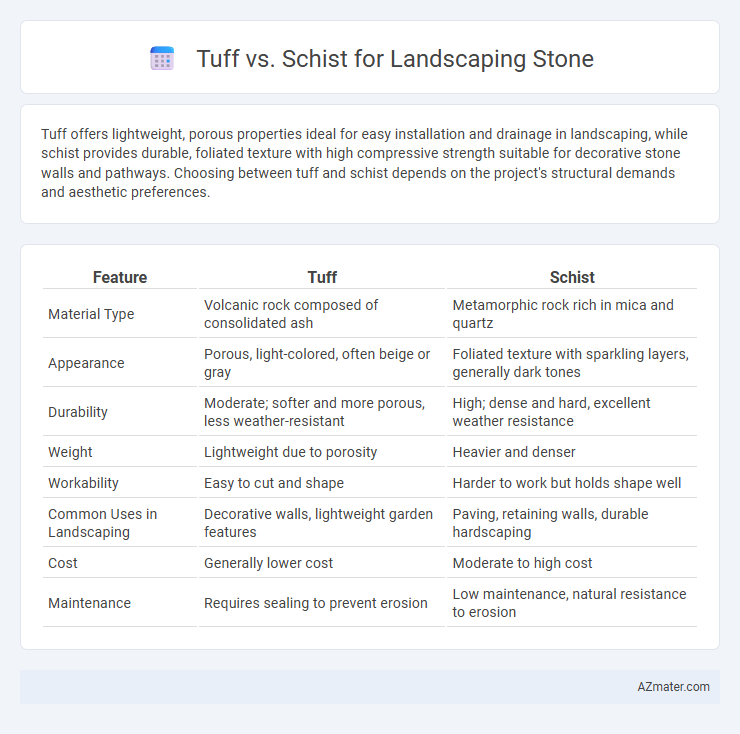Tuff offers lightweight, porous properties ideal for easy installation and drainage in landscaping, while schist provides durable, foliated texture with high compressive strength suitable for decorative stone walls and pathways. Choosing between tuff and schist depends on the project's structural demands and aesthetic preferences.
Table of Comparison
| Feature | Tuff | Schist |
|---|---|---|
| Material Type | Volcanic rock composed of consolidated ash | Metamorphic rock rich in mica and quartz |
| Appearance | Porous, light-colored, often beige or gray | Foliated texture with sparkling layers, generally dark tones |
| Durability | Moderate; softer and more porous, less weather-resistant | High; dense and hard, excellent weather resistance |
| Weight | Lightweight due to porosity | Heavier and denser |
| Workability | Easy to cut and shape | Harder to work but holds shape well |
| Common Uses in Landscaping | Decorative walls, lightweight garden features | Paving, retaining walls, durable hardscaping |
| Cost | Generally lower cost | Moderate to high cost |
| Maintenance | Requires sealing to prevent erosion | Low maintenance, natural resistance to erosion |
Introduction to Tuff and Schist in Landscaping
Tuff, a lightweight volcanic rock formed from compacted volcanic ash, offers excellent drainage and a porous texture ideal for garden pathways and retaining walls. Schist, a metamorphic rock characterized by its foliated texture and varied mineral content, provides durability and a distinctive shimmer, enhancing landscape aesthetics. Both stones bring unique structural and visual benefits, making them popular choices for diverse landscaping projects.
Geological Formation of Tuff and Schist
Tuff is a porous, volcanic rock formed from the consolidation of volcanic ash ejected during explosive eruptions, characterized by its lightweight and often irregular texture. Schist is a metamorphic rock resulting from the intense heat and pressure that realign minerals like mica into distinct foliation, creating a dense, layered structure. The geological formation of tuff involves rapid cooling of pyroclastic material, while schist forms over long periods through regional metamorphism and recrystallization of sedimentary or igneous precursor rocks.
Physical Properties: Tuff vs Schist
Tuff is a lightweight, porous volcanic rock with low hardness, making it easy to cut but susceptible to weathering. Schist is a medium to coarse-grained metamorphic rock with pronounced foliation, providing high durability and resistance to abrasion. These physical properties make tuff suitable for decorative, low-traffic landscaping areas, while schist is better for structural uses and high-traffic pathways due to its strength and durability.
Color and Aesthetic Variations
Tuff offers a wide range of warm earth tones, including soft reds, yellows, and browns, providing a natural, rustic appeal ideal for creating textured, inviting landscapes. Schist, characterized by its shimmering metallic flakes and varied hues from silver-gray to green and purple, brings a striking, elegant contrast suited for modern and sophisticated outdoor designs. The choice between tuff and schist significantly impacts the visual dynamic of landscaping, with tuff emphasizing warmth and organic textures, while schist highlights luster and unique color depth.
Durability and Weather Resistance
Tuff offers moderate durability and weather resistance due to its volcanic ash composition, making it suitable for soft landscaping applications in mild climates. Schist, characterized by its foliated metamorphic structure and higher hardness, provides superior durability and excellent resistance to weathering, ideal for harsh environments and high-traffic areas. Choosing between tuff and schist depends on specific landscaping requirements, with schist generally preferred for long-lasting stone features exposed to extreme weather.
Ease of Cutting and Installation
Tuff, a soft volcanic rock, offers superior ease of cutting and shaping for landscaping projects compared to the harder, denser schist, which requires more specialized tools and effort. Its lightweight nature simplifies transportation and installation, reducing labor costs and project duration. Schist, while durable and visually appealing, demands greater precision and time during installation due to its brittle and foliated structure.
Cost Comparison and Availability
Tuff generally offers a more cost-effective option for landscaping stone due to its widespread availability and easier quarrying process, making it less expensive than schist. Schist, characterized by its layered mineral composition, tends to be pricier because of limited sources and higher extraction and finishing costs. Availability of tuff in volcanic regions ensures greater supply, while schist's regional scarcity often leads to higher transportation expenses affecting overall pricing.
Environmental Impact and Sustainability
Tuff is a volcanic rock with lower density and porosity, allowing for better water absorption and reduced runoff, which benefits sustainable landscaping by promoting natural irrigation and minimizing erosion. Schist, a metamorphic rock, tends to be denser and less porous, potentially leading to greater surface runoff and less groundwater recharge, making tuff a more environmentally friendly choice for landscaping applications. The renewable availability and extraction impact of tuff are often lower compared to schist, supporting its use as a sustainable and eco-conscious material in outdoor design projects.
Best Landscaping Applications for Tuff
Tuff is an ideal landscaping stone for retaining walls, garden pathways, and water features due to its porous texture and lightweight nature, which facilitate drainage and ease of installation. Its natural weather resistance and soft aesthetic make it suitable for decorative boulders and rock gardens, adding rustic charm and durability. Unlike schist, which is heavier and has a foliated texture, tuff's versatility in shaping and resilience against erosion make it a superior choice for diverse landscape designs.
Best Landscaping Applications for Schist
Schist is ideal for landscaping applications requiring durability and aesthetic appeal due to its foliated texture and natural shimmer. Its ability to be split into thin slabs makes it perfect for patios, walkways, retaining walls, and decorative garden features, offering a rustic yet sophisticated look. Compared to tuff, schist provides greater resistance to weathering and erosion, ensuring long-lasting outdoor installations.

Infographic: Tuff vs Schist for Landscaping Stone
 azmater.com
azmater.com